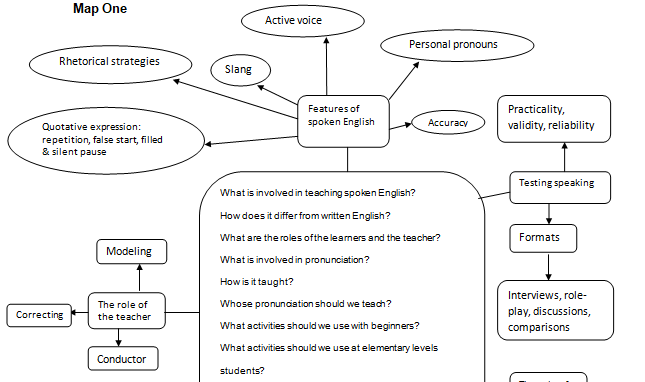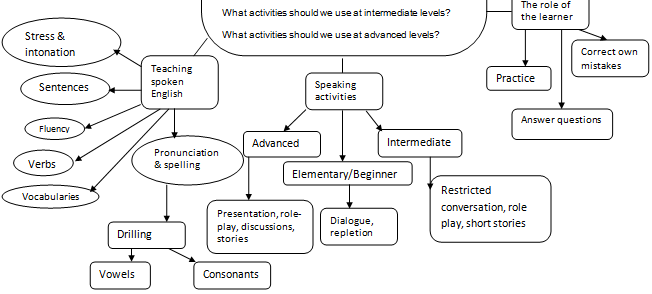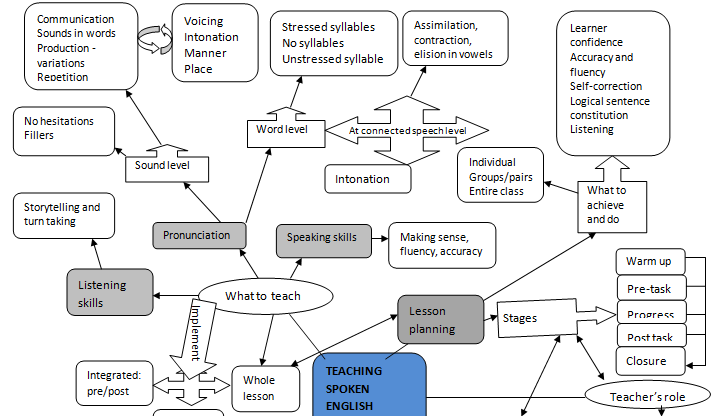



Differences between the two concept maps
The first map is a simple representation of what the teacher would involve in teaching spoken English. On the other hand, the second map is a detailed map with explicit contents of all elements of teaching spoken English, implementation, and evaluation.
The first map provides an overview of the lesson and its fundamental concepts. After the teacher had reviewed materials for teaching the spoken English to ESL class, he developed the second map based on new knowledge gained. Thus, the second map provides all features that the teacher requires to implement the lesson effectively.
The first map only presents various features of the spoken English. The second map gives different details of what the teacher should teach in the spoken English lesson. For instance, speaking skills, pronunciation, and listening skills are core aspects of spoken English, which are in the second map. They also extend to highlight specific levels of teaching i.e., word and sound levels.
Under pronunciation, we can see that drilling is the best approach for vowels and consonants as highlighted in the first map. However, the second map breaks it down to aspects like voicing, place, and manner. Moreover, there are other elements of pronunciation, which one can identify, such as communication, sounds, variations in sound production, and other non-fluency features like repetition.
It is also important to note that the second map has clearly identified specific roles of the teacher and students. One can also identify different levels of students’ capabilities like beginner or elementary, intermediate, and advanced levels.
The second map has introduced detailed elements of teaching. For instance, we have the whole lesson, the distinct phase, and the integrated phase. In the second map, the teacher can also identify assessment details of the spoken English lesson.
The second map has included planning details so that the teacher can have a logical way of teaching lesson contents. Therefore, the teacher can implement the lesson effectively without challenges. These features are not in the first map.
The second map has unique features, which interlinks the entire lesson and planning processes to all other activities of the lesson. For instance, there is a direct arrow from the whole lesson to lesson planning. Such arrows are also present in stages of lesson planning and the role of the teacher and students. In addition, there are also curves, which show the direction of movement between activities.
They show that the lesson is unified whole, and the teacher must follow sequences for effective implementation. This shows that knowledge acquisition in the spoken English lesson requires an integrated approach.
The first map lacks pictures. In the second map, there are pictures embedded within the lesson. For instance, effective teaching of spoken English requires the teacher and learners to interact.
The picture identifies interaction between the teacher and the learner in the learning processes. In addition, there is also a picture of learners engaged in role-playing (student-student interaction) and playing in order to learner voicing, place, and others.
Overall, the second map is a detailed presentation of how a teacher can implement a lesson plan of the spoken English in the ESL class. It shows logical sequences of learning and integration methods of teaching the second language and knowledge acquisitions.
An approach of teaching English I would use in the future
The initial approach would be to let students to understand the importance of spoken English in their lives. It is necessary for students to understand that the need to learn and apply spoken English has increased significantly among people from different parts of the world.
Students must understand that such needs arise due to international activities like trade, job opportunities, tourism, further education, and travelling or tourism.
Thus, people of different ages and nationalities want to learn spoken English to meet such needs. Learning spoken English will ensure that students can communicate clearly with self-confidence and effectively deliver their messages. They must also understand that English is a global language.
At this study level, (our study level is intermediate) the teacher knows that students will not be able to learn English as children do because it is a foreign language. Given the complexity of teaching spoken English (see the concept maps), it would be important to emphasise the role of practice in order to reduce effects of the first language on English.
I will let the student know that they need an extra effort to speak fluent and accurate English. I would also be interested in understanding what factors may hinder or motivate my students to learn spoken English. As a result, my future approach of teaching spoken English would be a comprehensive approach based on needs and motivation of students.
My students are Saudi Arabia intermediate English students. They have learned English in the previous years. However, I do not expect them to exhibit high-levels of confidence, accuracy, fluency, and vocabulary usages when speaking English. Thus, my approach of teaching spoken English will also motivate learners to overcome their difficulties.
My lesson would reflect the importance of teaching skills in listening, pronunciation, and speaking. These are important elements of effective communications. On this note, I would strive to understand general abilities and weaknesses of students in these aspects of spoken English.
Herbert asserts that teachers should identify challenges, which students have in order to focus on such challenges when teaching (Herbert, 2002, p. 188-200). I will recognise that teaching pronunciation goes beyond sounds. As a result, I will incorporate word stress, intonation, and stress in sentences as parts of pronunciation for ESL learners.
There are also linkages in words, which my lesson would explain. During my lesson, students would note the role of their mother tongues and their influences on pronunciation of English words. However, an effective practice would ensure that students gain confidence and improve their communication skills (Hewings, 2007, p. 30).
It will also be important to let students to know that it would be unrealistic to achieve the level of a native speaker in English pronunciation. It would also be important to encourage students to practice pronunciation whenever they find an opportunity to allow them lessen the effect of their native language on English.
Students will also learn speaking and listening skills. However, the choice of these skills would depend on the level of students’ abilities (intermediate). Initially, I shall encourage my student to master discrete skills in learning spoken English (Rost, 1990, p. 99-177). They will recognise various forms of words, cohesive text elements, and key words in spoken English.
These may form the basis of the lesson. However, I will introduce students to interpretive processes of listening in which we will engage in understanding conversation and discourse. Students shall engage in reading written texts loudly. During this process, I will emphasise the role of students whenever they are reading texts aloud.
For instance, contemporary approaches of teaching listening skills require students to be active participants in the process of learning. In this regard, I would encourage my students to develop their listening skills by using various strategies to enhance, monitor, and assess such skills. Thus, my class would emphasise the role of students as active listeners.
Doff observes that students must acquire both listening and speaking skills in order to realise successful conversations (Doff, 1988, p. 78-90). Traditionally, students would repeat what the teacher has said, memorise a conversation or a story and provide answer to drills.
These were sentence-based approaches to achieve proficiency in repetition or drill approaches. However, I would apply a communicative-based approach to teach spoken English (Richards, 2008, p. 1-2). In this context, I would encourage my students to develop speaking skills through generating ideas and solving tasks with the aim of developing fluency, accuracy, and vocabulary.
Thus, I would apply information-gap and encourage students to use spoken English in real communications based on knowledge acquired previously. This strategy would allow students to acquire skills in communication and engage in meaningful negotiations, which would help them to develop effective oral skills. I shall encourage clarity and observation of grammar rules as Hedge notes (Hedge, 2000, p. 259).
Teaching requires effective planning of the lesson plan. According to Butt, good planning, classroom management, and sustained performance are the best ways of ensuring effective learning (Butt, 2006, p. 65-80). As a teacher, I would make sure that I carefully plan my lessons by organising them in terms of introduction or warmer, pre-task activities, during tasks, and post-tasks activities.
Warmer activities would be useful for preparing students for active participation in the spoken English lesson. At the intermediate level, students will engage in discussions, peer-to-peer activities, self-tests, and evaluation. Every stage of the lesson would indicate the role of the teacher and students.
The aim of planning my lesson is to ensure that students remain active throughout the lesson. Baker and Westrup pointed out that engaging students in a lesson usually makes them active and apply acquired skills in learning (Baker and Westrup, 2003, p. 21-30). Engaging students in the lesson would ensure that they concentrate on learning activities.
Besides, I would be able to encourage slow learners to participate in various activities. Activities in teaching spoken English would be able to motivate students to contribute in learning and developing self-confidence for effective communication in English. Hedge encourages teachers to balance their lesson plans in spoken English so that students can develop both accuracy and fluency (Hedge, 2000, p. 259).
At the intermediate level, I would focus on both accuracy and fluency as we develop fluency because my student would not have mastered accuracy in spoken English. In my class, I shall encourage the use of information gap, restricted conversation, storytelling, role-play, jokes, discussions, and use of games.
I have also learned the importance of a good learning environment for learners. I shall ensure that the class has a favourable environment, which will encourage all students to take part in oral presentations. This would ensure that we do not leave slow learners as others progress.
Collie and Slater note that a favourable classroom environment can promote learning of fluency (Collie and Slater, 1993, p. 8). In this context, I would focus on effective topic presentation, classroom management and student participation. Student errors and feedback will form the basis of developing an evaluation plan. I shall provide feedback and encourage students to generate correct answers. No feedback shall upset any student.
I shall pay special attention to student assessment. Validity, reliability, and practicality of students’ assessment tools are critical for evaluation of the teacher’s lesson outcomes. It would be important to ensure that tests have a suitable scoring and grading rubric in order to enhance reliability of assessment tools. Burgess and Head note the importance of knowing test criteria among students (Burgess and Head, 2005, p. 99-120).
I would use different methods to test students learning outcomes. These may include information gap, interviews, and controlled interviews. I shall expect to see some levels of improvement among slow learners while fast learners will display improved fluency and accuracy.
Overall, my teaching approach would encourage students to master English speech sounds like vowels and constants, stress, intonation, and rhythm as they also recognise manner and place. It will encourage a reasonable level of accuracy, use of vocabulary, and fluency among students. Thus, students would know what to say, and how to say it in any given context.
References
Baker, J., and Westrup, H. (2003). Essential Speaking Skills. London: Continuum International Publishing Group.
Burgess, S., and Head, Katie. (2005). How to Teach for Exams. New Jersey: Pearson Education.
Butt, G. (2006). Lesson Planning. London : Continuum International Publishing Group.
Collie, J., and Slater, S. (1993). Speaking 3. Cambridge: Cambridge University Press.
Doff, A. (1988). Teach English: A Training Course for Teachers-Tacher’s Workbook. Cambridge: Cambridge University Press.
Hedge, T. (2000). Teaching and Learning in the Language Classroom. Oxford: Oxford University Press.
Herbert, J. (2002). PracTESOL: It’s not what you say, but how you say it. In J. C. Richards and W. A. Renandya (Eds.), Methodology in Language Teaching (pp. 188-200). Cambridge: Cambridge University Press.
Hewings, M. (2007). Pronunciation Practice Activities: A resource book for teaching English pronunciation. Cambridge: Cambridge University Press.
Richards, J. C. (2008). Teaching Listening and Speaking: From Theory to Practice. New York, NY: Cambridge University Press.
Rost, M. (1990). Listening in Language Learning. London: Longman.